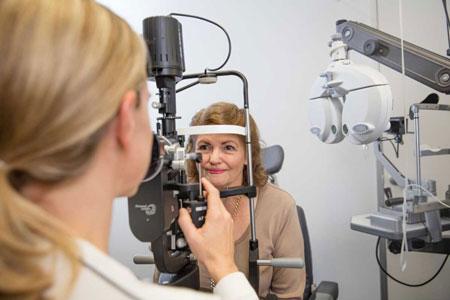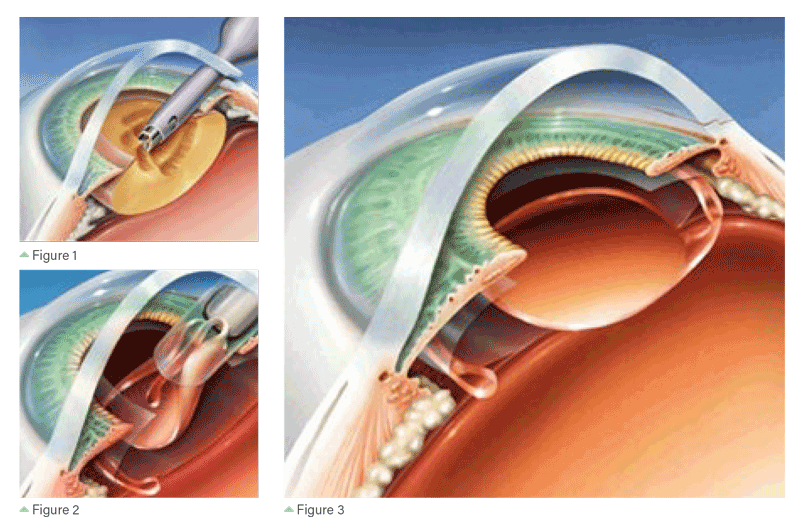Cataract surgery is a significant life event that can seem daunting, particularly if you do not feel informed about the process. To help with your decision making, our team of eye health experts have carefully crafted the Ultimate Guide to Cataract Surgery. It contains a range of information that will assist you to make an informed choice regarding your treatment and visual options.
We have summarised the guide here on our website, however, you can download the full Guide as a PDF to view at your leisure. Once you have reviewed the guide, we encourage you to contact the KindSIGHT team and set up a time to take the first step towards better vision for life.
WHAT IS A CATARACT?
A cataract is the gradual clouding of the natural or ‘crystalline’ lens inside the eye. This progressively degrades the quality of your vision over time, as if you are trying to look through a ‘dirty window.’
The clouding also causes light scatter, resulting in blurred vision, as well as glare symptoms. Because this is happening inside your eye, it means that eventually, even a new or perfect set of glasses will not be able to sharpen your vision.

ARE CATARACTS DANGEROUS?
Rest assured; a cataract is not dangerous or poisonous to the other parts of your eye. In fact, cataracts are common and a normal part of ageing. Much like getting grey hair, some of us will develop cataracts relatively early in life, while others will not be affected until much later.
Usually, cataracts develop in both eyes at around the same rate, so quite often you are not fully aware of how much your vision has slowly deteriorated over time. Occasionally a cataract in one eye may be far more advanced than in the other, and in this case, there is an obvious difference in the vision between your eyes.
WHAT CAUSES CATARACTS?
It is not fully understood why the lens of the eye changes as we mature in age, eventually forming a cataract. Oxidative damage to the lens proteins throughout our lifetime is likely to play a major role.
Other factors thought to contribute to cataract development include:
- diabetes
- smoking
- UV radiation
- obesity
- high alcohol consumption
- family history
- high myopic error
- hypertension
- extended use of corticosteroid medication
- hormone replacement therapy
- cholesterol lowering medicine
- previous eye surgery or injury

WHAT ARE THE SYMPTOMS OF CATARACTS?
- Your glasses always seem dirty
- Small print is harder to read
- Change in colour vision
- Sensitivity to bright light
- Trouble seeing signs in the distance
- Double vision in one eye
- Night driving difficulty due to glare and haloes around traffic/car headlights
WHEN SHOULD YOU HAVE CATARACT SURGERY?
Worldwide, cataract surgery is the most frequently performed surgical procedure. In Australia, more than 200,000 cataract procedures are performed every year.
Cataracts can be removed at any stage and you do not have to wait for them to ‘ripen’ before having surgery. Because cataracts will continue to progress over your lifetime, if not treated they will eventually cause blindness.
No matter how mature your cataracts are, it is always ‘possible’ to remove them.
The decision to proceed with cataract surgery ultimately comes down to whether you perceive the benefit of having the operation outweighs the small risk associated with treatment. The cataract eye surgeons at KindSIGHT are only too happy to discuss this in detail with you.
The timing of surgery is different for everyone.
Making the decision to have your cataracts removed usually depends on the following:
- The degree your sight is affected
- Your most common daily activities or vision requirements
- If you only have sight in one eye
- If you have any other eye disease
Worldwide, cataract surgery is the most frequently performed surgical procedure. In Australia, more than 200,000 cataract procedures are performed every year.
Cataracts can be removed at any stage and you do not have to wait for them to ‘ripen’ before having surgery. Because cataracts will continue to progress over your lifetime, if not treated they will eventually cause blindness.
No matter how mature your cataracts are, it is always ‘possible’ to remove them.
The decision to proceed with cataract surgery ultimately comes down to whether you perceive that the benefit of having the operation outweighs the small risk associated with treatment. The eye surgeons at KindSIGHT are only too happy to discuss this in detail with you.
The timing of surgery is different for everyone.
Making the decision to have your cataracts removed usually depends on the following:
- The degree your sight is affected
- Your most common daily activities or vision requirements
- If you only have sight in one eye
- If you have any other eye disease
GET A VISION OUTCOME TO SUIT YOUR LIFESTYLE
Everybody is different and there is no ‘one size fits all’.
Thanks to advances in technology, including the types of intraocular lens implants (IOLs), advanced micro-incision cataract surgery provides the opportunity to tailor a vision solution that best suits your work and leisure activities to a far greater degree than ever before.
ADVANCED CATARACT SURGERY?
The modern surgical procedure is known as ‘phacoemulsification.’ In brief, this involves removing the cataract using a sophisticated ultrasound probe and replacing it with a clear artificial lens, known as an ‘intraocular lens’ or ‘IOL’ for short.
This procedure aims to provide you with a significant improvement in the clarity, brightness, and sharpness of your vision. It is very important however to understand that cataract surgery will not restore vision that has been lost through other eye diseases, such as macular degeneration or glaucoma.
Over the past decade, there have been significant advances in cataract surgery. In most cases, the operation is performed under ‘twilight anaesthetic’, using only local anaesthetic eye drops (no needles), in a convenient day surgery environment. There is minimal discomfort, no eye pad is required and the recovery is usually rapid. Most patients have ‘driving level vision’ within 1 week.

PHACOEMULSIFICATION
THE SURGICAL PROCEDURE
The operation is microsurgery, meaning it is performed using a high-powered microscope. A small speculum is gently placed in order to keep your eyelids apart throughout the procedure, so don’t be concerned about keeping your eye open and not blinking!
Two small incisions (1.0mm & 2.2mm) are made in the edge of your cornea, then the ‘capsular bag’, which covers the natural lens, is opened to create a circular hole called a ‘capsulorrhexis.’
An ultrasonic or ‘phacoemulsification’ probe is then introduced into the eye through the main corneal incision. It uses sound waves to break the cloudy lens into fragments, which are then small enough to be extracted through the attached suction port (Figure 1).
Once the capsular bag is clear of lens material, the artificial, or intraocular lens is implanted into your eye using a specialised lens injector (See Figure 2). The new lens unfolds inside the empty bag and is held in place with the aid of the IOL haptics (See Figure 3). The tiny 2mm corneal wounds are usually self-sealing, so stitches are rarely needed.
The IOL is approximately one-third the width of the natural lens that was removed, meaning that initially, the capsular bag is somewhat ‘floppy’ immediately after surgery. It takes a month or so for the capsular bag to ‘shrink wrap’ around the artificial lens and hold it firmly in position.
COMBINING LIFESTYLE & VISION OPTIONS
WHAT IS AN INTRAOCULAR LENS (IOL)
An IOL’s will be your new lens!
They are made from a specialised plastic polymer.
A wide variety of IOLs are available, however, they all share the same general design.
Based on your lifestyle we will recommend an IOL that will best suit you. Each lens has different advantages and limitations. These will all be discussed with you n detail prior to surgery to ensure you get the best outcome.

OPTIC: contains the focusing part of the lens
HAPTIC: holds the lens in place within the capsular bag

 NEAR
NEAR
 INTERMEDIATE
INTERMEDIATE
 DISTANCE
DISTANCE
MEDICARE NO GAP APPOINTMENT
INDOOROOPILLY or REDCLIFFE
Make a no obligation Medicare No-Gap Appointment to discuss your concerns and treatment options.
If surgery is recommended we will discuss the options so you can make an informed decision.
MATCHING YOUR VISION TO YOUR LIFESTYLE
LIFESTYLE QUESTIONNAIRE?
The best visual outcome is achieved when we fully understand your unique vision needs and preferences.
To achieve this our patients are asked to complete a detailed lifestyle questionnaire. This enables us to recommend the best treatment and vision option for your individual lifestyle.
BEFORE CATARACT SURGERY
FREQUENTLY ASKED QUESTIONS
In many cases the answer is YES – you will enjoy increased freedom from your spectacles. However,
you must remember that everybody is unique with their own set of eye health issues and lifestyle
requirements.
During advanced cataract surgery, the surgeon removes your cloudy cataract and inserts a new, artificial
intraocular lens (IOL). There are a wide variety of IOLs available in Australia, however they can be grouped
into three (3) main categories based on their optical properties. They include: ‘monofocal’ IOLs, ‘extended
depth of focus’ IOLs and ‘multifocal’ IOLs. For each IOL type there is a toric or astigmatism correcting
version available.
The IOL that is ultimately used will be selected based upon what type of vision you want to achieve in the
long term, that will allow you to live the lifestyle that you want. The ‘Vision for Life’ section of this eBook
describes this in more detail.
More information can be found in our Ultimate Guide to Cataract Surgery.
Yes, cataracts can cause blindness. Fortunately, however, this can be cured by performing cataract
surgery. In fact, often the vision is so good a person can usually legally drive without glasses after surgery.
It is best not to wait until your vision is severely reduced. Cataract surgery is technically easier and
treatment less complex if performed before the vision progresses to legal blindness.
Not surprisingly, this is a common question! The answer is that you will not feel any pain during surgery. Most likely, you will be sleeping lightly and have very little memory of what occurred in the operating theatre afterwards.
When to have surgery is always a personal choice. If you are noticing vision problems and your
optometrist or doctor has told you that you have cataracts, it is likely that your cataracts are bad enough
to require surgery.
Early symptoms of cataracts include trouble reading small print along with losing confidence driving
at night due to haloes or struggling with glare during the day. Having to update the prescription in your
glasses more frequently is common as cataracts progress. These symptoms can become noticeable to
you even before your eye care provider notices significant clouding of the lenses of your eyes.
People who need excellent night vision for driving will often seek cataract surgery early on rather than
wait for loss of lines on the vision chart. Others who are not experiencing symptoms may wait until later,
although it is important to have regular eye examinations to monitor your situation and avoid your vision
slipping to the point that driving becomes dangerous.
Toric IOLs are the astigmatism correcting version of each of the 3 major IOL types available in Australia – monofocal, extended depth of focus and multifocal IOLs. Technically, the steps during the operation are the same between IOL types, however toric IOLs are orientated on a specific axis inside the eye.
This axis has been specifically calculated for your eye, based on the measurements taken at your pre-operative assessment.
All intraocular (IOL) types are made from similar material, a specialized plastic polymer. Remember, the
IOL is a small, inflexible, man-made piece of technology. Currently, there is no IOL available anywhere in
the world that can perfectly replicate the optics of a young, healthy, natural crystalline lens, which can flex
and therefore change focus, known as ‘accommodation’.
This ability of the young lens to ‘accommodate’
facilitates crystal clear vision spanning the near, intermediate and distance range without the need for
glasses.
It is important to understand that despite incredible advances in technology over the past decade, there
are limitations regarding what can be achieved by cataract surgery.
No. Cataract surgery is performed under ‘twilight sedation’. You will be very relaxed and comfortable and have no memory of your surgery. A general anaesthetic, where a breathing tube is inserted and a ventilator is used, is not needed. In fact, a general anaesthetic has significantly more risks associated with it compared to twilight sedation.
It is completely normal to feel apprehensive or nervous about an operation. You will be provided with the details of your anaesthetist prior to your surgery and are encouraged to contact them for discussion if you wish.
Although around the world there is research into eye drops which reduce the damage to the lens caused
by natural ageing, currently there are no eye drops available in clinical practice. The only treatment for
cataracts is clinically proven cataract surgery. Cataract surgery also allows you the option to correct your
focus problems at the same time, which eye drops will never do.


